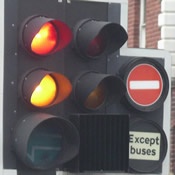What is Traffic Light Priority?
Traffic Light Priority (TLP) reduces the impact of congestion by offering buses priority through junctions. This helps to promote modal shift by improving the speed of bus services relative to private vehicles. Furthermore, local operators can run more profitable commercial services, encouraging them to increase regularity of services and thereby further improving the experience for passengers.
What’s different?
As effective as Traffic Light Priority is, until now there was always the limitation that the on-bus equipment was able to instigate a TLP request to the Traffic Management System, but there was no way to receive feedback regarding the request: it was therefore not possible to understand whether the request was acted upon, or even received.
At Trapeze we have been working to improve this process, and alongside the RTIG working groups we have been able to drive through a change to the RTIG T031 protocol. The new version 1.1 of the protocol supports traffic management system responses so local authorities can see whether responses have been received and then acted upon.
Additionally, NOVUS users can also now define sets of junctions that are owned by different traffic management systems, with different destinations to which to send messages. Users can filter out messages based on criteria such as service schedule adherence; and there is a priority override that enables prioritisation to be adjusted based on configurable conditions.
So what?
By adopting the new protocol, users are able to measure the performance of a TLP system more accurately. This means you will be able to work with your traffic management supplier more effectively to establish improvements, and thereby ensure maximum benefit from your TLP system, reducing the impact of congestion on bus services, and increasing modal shift.





